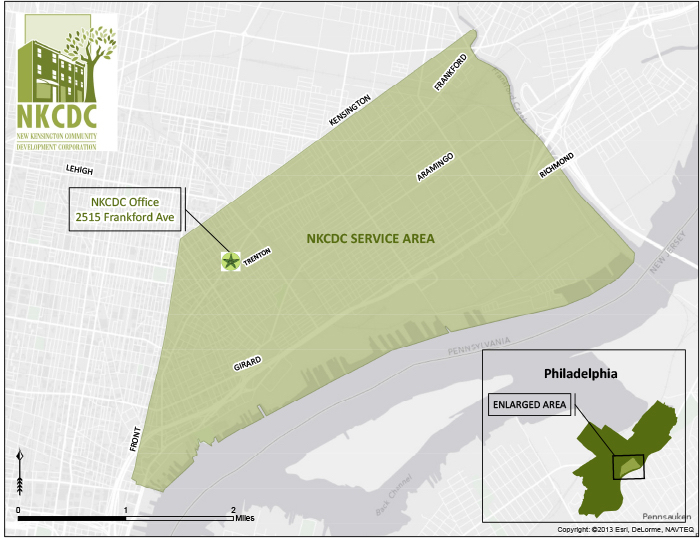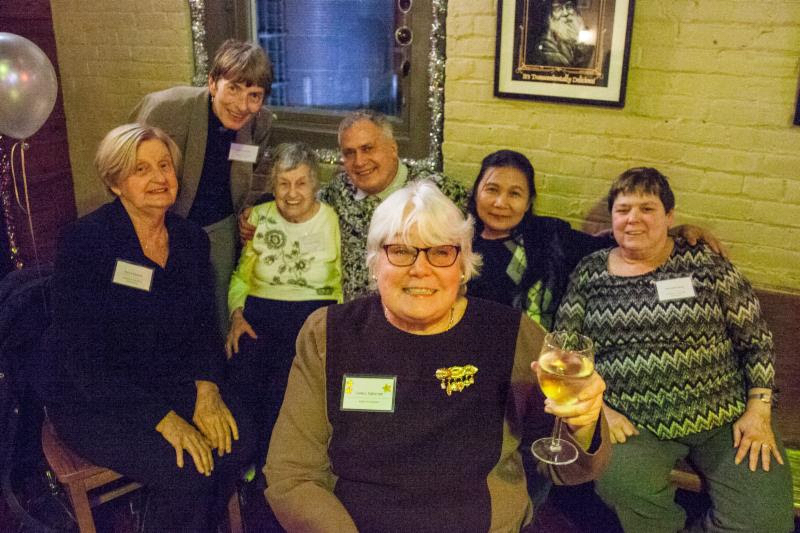Moving On: NKCDC Executive Director Sandy Salzman
 December 14, 2016
Category: Featured, Long, People, Q&A
December 14, 2016
Category: Featured, Long, People, Q&A
“Moving On” is a series of Q&As with social impact leaders who are leaving their organizations for new opportunities. Here, they share what they learned and where they’re headed.
The Orinoka Civic House project is a big deal.
The 70,000-square-foot former textile factory, once a decrepit sign of squalor looming over the Somerset El stop, is being transformed into a shiny, mixed-use property with room for 51 low- and moderate-income housing units, commercial space and offices for New Kensington Community Development Corporation (NKCDC), the organization behind the rehabilitation.
Sandy Salzman is a big deal, too. I first met the longtime ED of NKCDC in May 2014 when reporting on her receipt of the Woman of Courage Award from Lutheran Settlement House. She struck me as self-effacing, soft-spoken — and yet, the kind of person who doesn’t put up with your bull.
In her 21 years at the helm, the fourth-generation Fishtowner has overseen the conversion of a vacant factory into the residential Coral Street Arts House for low-income artists, the revitalization of more than 90 percent of the 1,100 vacant parcels in Fishtown and most recently the development of that former textile factory.
Salzman announced her retirement this past October. In her “Moving On” interview with me (Generocity Editor Julie Zeglen), she discusses what it took to get the Orinoka Civic House project off the ground, why a good CDC puts itself out of business and how the neighborhood she’s lived in her entire life has changed for the better. Our conversation has been edited for length and clarity.
Generocity: Why are you leaving?
Sandy Salzman: Because it’s time. In addition to having done this work for 38 years now, we’re getting ready to move further to the north to the other side of Lehigh Avenue, and we’re going to be moving our offices. It just seemed like a good time to do it would be now, as we’re moving forward. It’s not easy.
G: For anyone who is not familiar with the work that’s been done over the last couple decades, can you share how the neighborhood has changed? What is the Fishtown-Kensington area that you remember growing up, and what is it like now?
SS: When I was growing up, I lived on Frankford Avenue. The edges of Fishtown were not in great shape, [though] the center of the neighborhoods were strong, the residential areas. The same could be said for Kensington.
The neighborhood was starting to see deterioration. People were not moving into the neighborhood. There was a lot of abandonment. There was a lot of vacant land. We did a survey in ’95 and found that at that time, there were 1,100 parcels of vacant land in the area from Lehigh Avenue and the Market-Frankford El to the [Delaware] River. A lot of vacant land — and 90 percent of it, probably, was filled with trash.
When I’m walking on Frankford Avenue today, there’s so many people walking around and there’s all these shops and bars and restaurants. It’s such a thriving area today. When I was a kid, there was one restaurant on Frankford Avenue. Johnny Brenda’s was a bar, it was there, but it wasn’t like you went down and had dinner, right? It’s where your father went and hung out with his men friends. It’s a lot different today than it was then.
Even something as simple as Penn Treaty Park — Columbia Avenue used to go all the way down to the river, and there were boats tied up there. It wasn’t this great, big, expansive Penn Treaty Park that we have today. That didn’t happen until 1982. So, there’s a generation and a half of people who don’t know what it was from what it is today. And that’s not a bad thing — it’s a good thing.
The neighborhood is certainly thriving and getting better, and the funny thing is that, when I was a kid, when you went under the [Lehigh] Viaduct and you went up into Kensington, Kensington was the stronger of the neighborhoods, right? K&A [Kensington and Allegheny avenues, which now has a notorious open-air drug market] was where everyone wanted to go shopping, because that’s where all the cool stores were, the good stores.
G: Wow.
SS: It’s such a flip-flop today. One of the things I’m happiest about now that we’re working in that neighborhood is, it’s going to be the neighborhood of my youth. Both neighborhoods will be strong neighborhoods and places where people are very proud — though, our neighborhoods are funny, because we’ve always, always been proud. Even when they weren’t at their best.
G: The big project for NKCDC now is the Orinoka Civic House.
SS: Oh, we’ve broken ground, it’s underway, they’re putting the windows in, they already dropped the floor — it’s really moving along.
G: When is it expected to be finished?
SS: It’s expected to be finished in June. It’s going to be an incredible game-changer for that area because it’s a big building and in order to help stabilize that area, we needed to do it. It’s going to be 51 units of low-moderate-income housing.
G: I’ve seen the building itself before anything was done to it, and it is very striking, because it’s a giant building and was in very bad shape before. Can you talk a bit about what it took to get that project off the ground?
SS: [Laughs] It took years, literally. The Orinoka Mills building was the biggest, baddest, ugliest thing going. We worked really, really hard with lots and lots of people from the Redevelopment Authority and the Office of Housing and Community Development and Councilman [Mark] Squilla and Councilwoman [Maria Quiñones] Sánchez, the Commerce Department — all these city agencies, to try to get this building. It had over a million dollars of liens against it. The city had to take it through sheriff sale. And then of course, we had to raise the money to renovate it — a little over $17 million.
G: About two years ago, you told me, in relation to the Orinoka Mills project:
“The job of a CDC is to put itself out of business; that’s what a good CDC does. It comes into an area that needs renovation, it helps rebuild the neighborhood with the residents, and then you move on, or you go out of business.”
I think that that’s a really bold statement, first of all, because most businesses don’t operate like that.
SS: Right. But most businesses aren’t CDCs. That’s what a community development corporation does, and that’s what we’ve done. In Fishtown, we put ourselves pretty much out of business.
G: So, what does that mean for the continuing future? What do the next 20 years look like?
SS: [Laughs] Ah, that’s going to be for the next executive director to figure out. Obviously, we do have a plan for North of Lehigh of what we would like to see happen. We’re very concerned about things moving too quickly up there. We don’t want to see people in that neighborhood displaced because of gentrification. I mean, that would be horrible to me. But we do want to make the neighborhood better. We are working with other agencies to try to help people fix up their houses so that they will be able to stay in the neighborhood.
Our boundaries now go up to Frankford Creek, which is a ways up, and there’s a lot of work to be done in that area up there. We’re working with Impact Services, Shift Capital and a number of other for-profit entities.
It’s challenging because there are a lot of problems in this area, as you probably know. Homelessness has been pandemic, almost, in that area, and the drugs. We need to deal with this in a more sensitive way than just going in and cleaning it out. You can’t move people out if you don’t have services in place to take care of them, and that’s what we’re trying to do by working with Impact Services, Prevention Point, etc. to make sure that this gets taken care of in the right way.
G: I’m sure it’s going to be a tough transition overall, with the knowledge transfer of you having 21 years of experience.
SS: I’ve been trying to make sure the staff knows [that information], having them go out to the meetings so the different powers that be know them. My staff here is amazing, so I want them to get recognition and to be the ones the city people know.
G: What is something the average Philadelphian should know about the work that’s being done here at NKCDC?
SS: The work we do basically bubbles up in the community. For instance, we needed to get the vacant lots cleaned up. But that’s not something that somebody sitting in an office here came up with you. We did a plan with the neighborhood, and one of the things that the neighbors said was, “We have all this vacant land, and I’m really embarrassed having people come to my house and see that trash dump down the street. Is there something we can do about that?”
As a CDC, we were able to get the agencies, the funding, so we could pay for this. Now, 20 years later, a lot of that vacant land has been cleaned up — and not even that, but built on. So obviously, it works.
G: Any words of wisdom you’d like to share?
SS: [Laughs] I don’t have any words of wisdom. I don’t even know what I’m going to do after I retire! That’s the hard question everyone keeps asking me. I’ll figure it out. I’m sure it will be fine.
Something amazing. Or not.
Project
Moving OnTrending News











